Exploring Deep Neural Networks for Temporal Information Extraction

The idea of neural networks has been proposed since the 1980s. It was sadly imprisoned by the computational ability of hardware and also the shortage of data amount at that time. Neural networks are designed to have the capability to automatically learn feature reprensentations from a large amount of data. With the development of hardware (GPU) and some key NLP components, such as dense word representations (word2vec, BERT, etc.), neural networks start to show the abilities of boosting state-of-the-art performance in many NLP tasks. In this research, our goal is to challenge the task of classifying the temporal relations between events in natural language texts by exploring various neural networks. We plan to utilize our models on both English (TimeBank) and Japanese (BCCWJ-TimeBank) corpora.
Generation of temporal concepts from spatial cognition
This research reveals temporal and spatial cognitive processes in languages of, and nearby, the Japanese archipelago including the Kyushu dialects, Korean, and Ryukyuan languages. The process is achieved through a strictly-controlled experimental methodology. In addition to the linguistic analysis, we try to elucidate the spatiotemporal cognitive process through the use of an experimental method using gestures accompanying speech and various experimental devices. Recordings of adjunct gestures, in keeping with the method developed by Rafael Núñez, one of the pioneer researchers in the field, an attempt is made to establish the relationship among proximal linguistic expressions ("ko-series"), focal elements currently being processed in mental processes and the current time. Further, it is expected that the relationship between the medial ("so-series") and the "event time", the distal ("a-series") and "past time", will become clearer. This study is the first to attempt to clarify the correlation of the process of space and time processing in discourse management theory through the analysis of micro gestures, and aims at a clarification of the mechanism of time recognition that is universal to human language.
Analysis of Subjective Time on Mind Time Machine
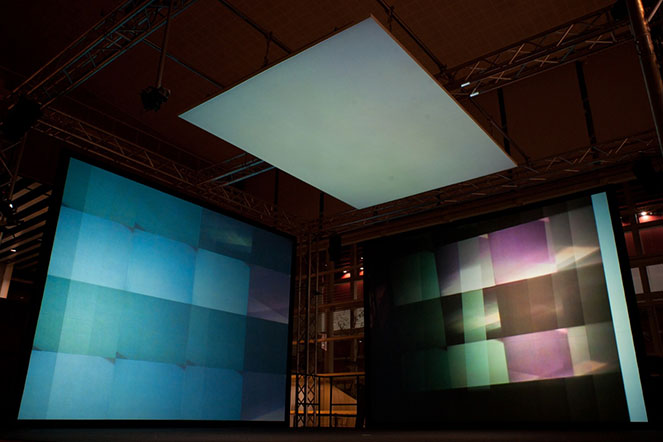 Mind Time Machine, YCAM, 2010
Mind Time Machine, YCAM, 2010
The aim of this project is to elucidate constructively what kinds of system-specific subjective time emerge from an artificial system which recevies various and multiple sensory inputs.
In 2010, we developed a video feedback network system called Mind Time Machine (MTM), which has an adaptive neural network that includes chaotic dynamics inside the system and receives visual data from its environment using 15 video cameras. This system was based on Benjamin Libet's studies and we investigated the change in learning and memory of the system over the months (Ikegami, 2010, 2013).
In this project, we will analyze a self-organized new time structure in an artificial system based on the recent technology on deep neural networks and the new concept of "generative subjective time".
Takashi Ikegami Studying a self-sustainable system by making a mind time machine. ACM Digital Library. 2010
Takashi Ikegami A Design for Living Technology: Experiments with the Mind Time Machine. Artificial
Life, Summer/Fall 2013, Vol. 19, No. 3(4), pp. 387-400, 2013
A neural mechanism of regulating the vocal rhythm and sequence
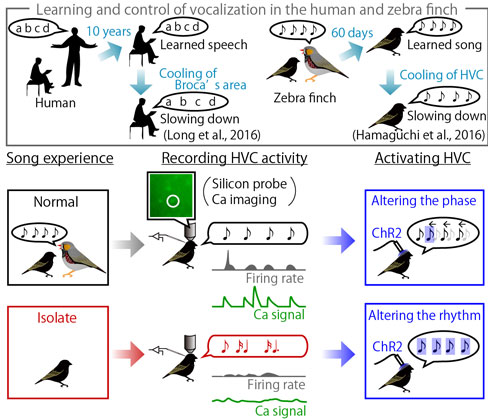
This project aims to elucidate the neural mechanism underlying the speech rhythm, by focusing on a songbird species, the zebra finch, which uses rhythmic vocalization similar to human speech for social communication. This study will test whether the synchronous oscillation found in a sensorimotor area HVC (Hamaguchi et al., 2016) regulates the vocal timing in the songbird, and examine how HVC develops the synchronous oscillation in the course of vocal learning. Also, this study will virally express channelrhodopsin (ChR2) in HVC neurons and activate/inactivate a subset of HVC neurons during vocalization to explore the causal relationship between HVC activity and vocal timing. By exploiting the zebra finch, an animal that is relatively inexpensive and develops fast, this study will efficiently explore the neural activity regulating vocal rhythm at the synaptic/cellular level. Given the similar function of HVC and Broca's area in regulating temporal aspects of vocalization, our results may shed light on the neural mechanism of how humans acquire rhythmic vocalization and control the rhythm in social communication.
Neural mechanisms for a predictive motor control
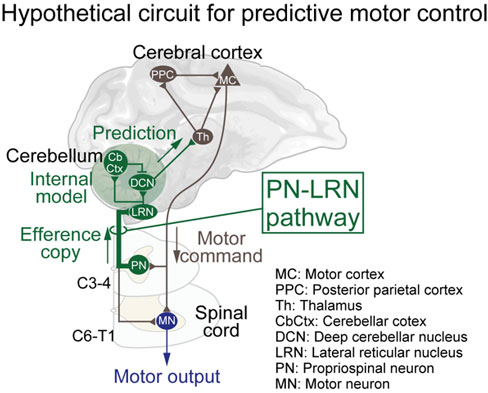
A hallmark of our motor system is the ability to predict the future changes in environment and our body and flexibly adapt current motor actions to them. The goal of this project is to understand the neural basis for adaptive motor behaviour. Our approach is multidisciplinary, including i) viral manipulation of neural circuits in animal models, ii) robotic assessment of motor behaviour, and iii) computer simulations based on motor control theories. By taking advantage of these diverse techniques, we aim to define the hardware (neural circuits) and the computation (functions) for adaptive motor behaviour.
Manipulation of subjective time by perceptual learning and neuromodulation
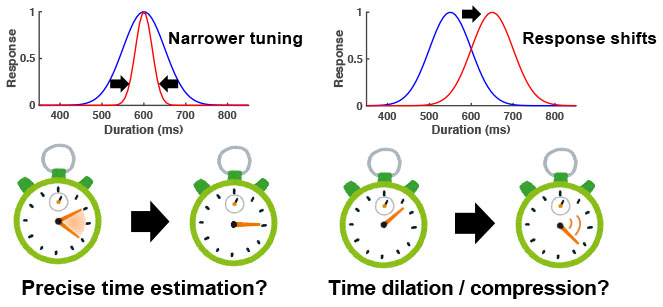
Our sense of time is not as precise as a clock or stopwatch but can easily be modulated by various factors. The neural mechanisms of the subjective experience of time, however, remain largely unknown. Our recent works in humans suggested that the subjective time may be mediated by the output of neurons that are tuned for hundreds of milliseconds. Based on this idea, my research project examines the causal relationship between the subjective time and duration selectivity by manipulating the response properties of the duration-tuned neural populations in the parietal cortex using non-invasive brain stimulation and perceptual learning techniques. Through the series of experiments, our project clarifies the neural mechanisms underlying the subjective experience of time and establishes the means to control our sense of time. The research outcome would help us to build a model of human time perception that explains various types of perception and behavior that involves explicit or implicit time estimation.
Analysis of neuronal activity encoding the timing of movement by two-photon imaging and optogenetic techniques
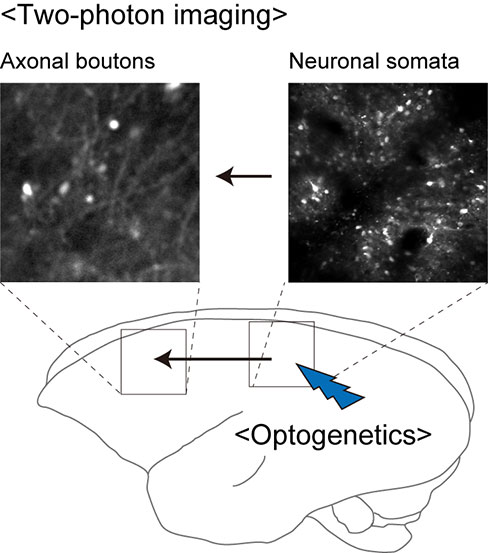
In this project, we will investigate neural mechanisms on how sensory input generates neuronal activity encoding the timing of movement. To this, we record activity of neuronal somata and axonal boutons using two-photon imaging in several cortical areas of common marmoset performing behavioral tasks. In addition, we modulate neuronal activity in the areas with optogenetic technique during the task to reveal how the activity in the area changes the activity in other areas and the behavior.
Neural substrates of waiting time decisions based on past reward delays
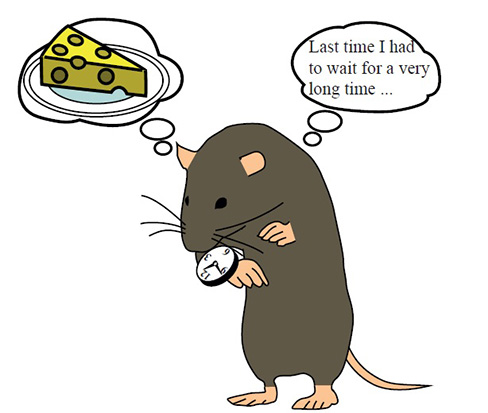
What will you do if your daily commuter train is delayed and you don’t know when it is going to arrive? In this situation, you need to decide how long to wait for the train and when to give up waiting and take another option. This decision should rely on your past experience of how long you had to wait in a similar situation.
In this project, we will study neural substrates of waiting time decisions that take place when an animal is waiting for a delayed reward. How do the frontal cortical areas use the information about previous reward delays to adaptively choose the waiting time? How do they control downstream brain areas to facilitate/suppress giving up waiting? To address this question, we will combine our newly devised mouse behavioral paradigm with a large-scale neural recording, anatomical tracing, and optogenetic/pharmacogenetic manipulation.
Manipulations of interval timing perception by external stimulations
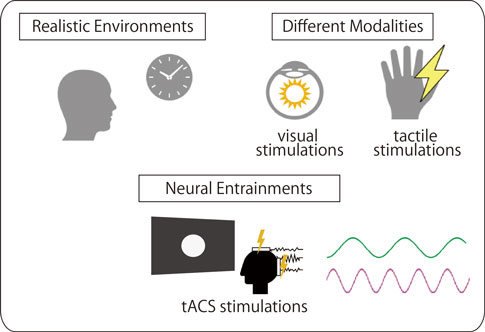
Modulations to visual stimuli induce neural entrainments and result in changes in the perceived duration. We will use tACS as a tool to induce neural entrainments, and a tactile stimulation device to apply tactile stimulations to human subjects. The aims of our study are:
(1) To examine whether we can induce neural entrainments by tACS and change the perceived duration.
(2) To examine whether we can manipulate perceived durations in more realistic non experimental environments.
(3) Whether we can manipulate perceived durations by tactile stimulations.
In the experiments, we will use stimulations in various frequencies, at various areas, and parametrically examine effects of stimulations on the perceived durations.
Neuronal mechanism regulating time-dependent sleep pattern
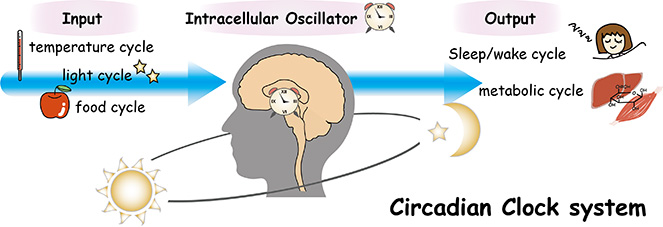
Organisms possess cell-autonomous body clocks to adapt to environments. Especially, the circadian clock generating biological rhythms with a period of ~24 hours is widely conserved in various species. In mammals, the master clock (central clock) resides in the suprachiasmatic nucleus (SCN) in the hypothalamus. This tiny nucleus is considered heterogeneous and to be composed of “intracellular time-keeping cells”, “output cells to send time information to peripherals” and “input cells to entrain to environmental cycle” (Figure). However, there are few studies trying to understand character and function of a specific population in the SCN. In this study, we focus on output pathway of time information from the clock and aim to determine the neuronal network and its function in regulation of sleep/wake rhythms. For this purpose, we utilize Cre driver mouse lines and virus vectors to manipulate specific neurons in the SCN. Our goal is integrative understanding of the circadian clock system and dynamics of time information in the brain.
Evolution of the time window of integration: comparative auditory evoked potential study with humans, macaques, marmosets, and dolphins
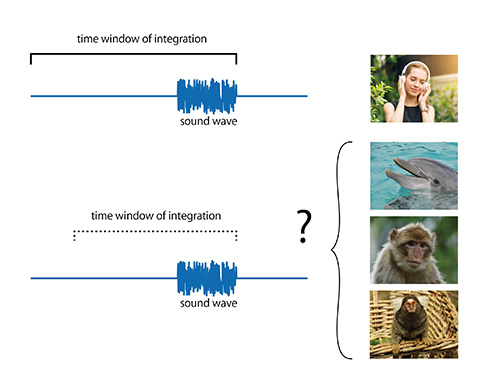
Sensory information is integrated over time for obtaining neural representations of sensory events in the brain. Temporal integration occurs at each level of sensory processing, from peripheral to central, and the time scale of integration generally becomes longer at higher levels of processing, reflecting accumulation of information over time. It would not be surprising if there were species differences in the time window of integration at the level of cerebral cortical processing. However, this possibility has never been investigated in neuroscience, to our knowledge.
This project uses noninvasive recording of auditory evoked potentials (AEPs) to address this problem in a comparative auditory neurophysiology experiment using humans, macaques, common marmosets, and dolphins. A unique advantage of noninvasive AEP is that, by using a common measure across species, direct species comparisons become possible. We aim to delineate species differences in the time window of auditory integration, by measuring AEP indices that have been established in humans to reflect temporal integration in hearing.
Neurobiological investigation into the developmental course and its individual differences in the influences of emotion on time perception
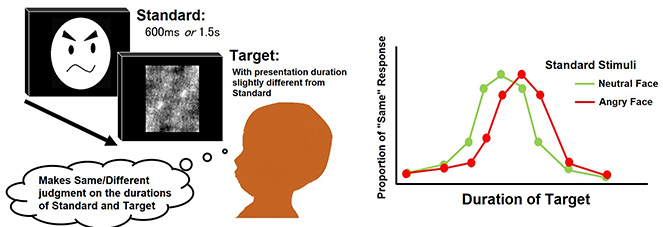
Time goes by very slowly when you are having dinner with someone unpleasant or being harshly scolded. Accordingly, previous psychological studies have shown that unpleasant emotion slows the flow of time or elongates perceived duration. Furthermore, recent studies revealed association between the influence of negative emotion on time perception and individual’s anxiousness that is at least partially determined by biological makeup.
On the basis of these previous findings, it seems conceivable that biological factors linked to anxiety as well as developmental stage yield great diversity in the subjective experience of time in developing populations. The present study aims to describe this diversity on empirical grounds by interdisciplinary approach that measures (i) biological predispositions linked to the activations of serotonergic/oxytocinergic neural system and (ii) the emotional influences on duration perception in children from preschool years to adolescence.
Interacting mechanisms between self and time in human episodic memory and confabulation
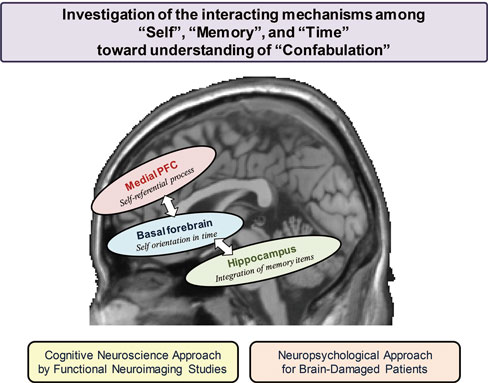
Confabulation is often observed in amnesic patients with basal forebrain lesion, and is defined as "falsification of memory occurring in clear consciousness in association with an organically derived amnesia". Previous studies have reported that memory disturbances are important in causing the confabulation, whereas the confabulation symptom is not always observed in all types of amnesia. Thus, little is known about the neural mechanisms associated with impaired psychological processes to cause the confabulation. In this project, we hypothesized that the confabulation could be related to the disturbance of interaction between "self" and "episodic memory" with the mediation by "time orientation", and that the disturbed interaction among the self-related medial prefrontal cortex (mPFC), the memory-related hippocampus, and the basal forebrain related to the time orientation could be critical in generating the confabulation. To tackle the research question, we employ two methods of cognitive neuroscience approach by human functional neuroimaging and neuropsychological approach for brain-damaged patients.
Comparative cognitive neuroscience on timing and time perception
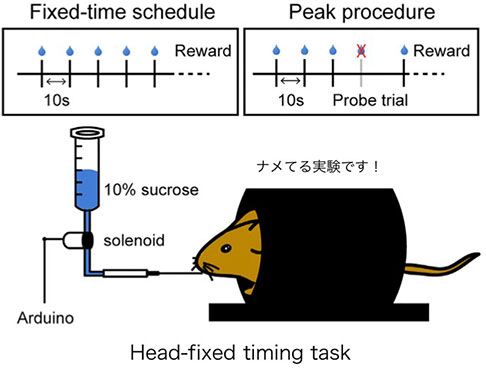
Time perception is unique because there are no dedicated sensory organs or receptors for time. The brain appears to create the subjective sense of time by integrating a variety of sensory inputs and internal states. We designed a novel task for studying interval timing in head-fixed mice during optogenetic manipulation of defined neuronal populations (Toda et al., 2017). Using a fixed time schedule of reinforcement, we trained mice to exhibit accurate timing behavior within a few hours. Using this quantitative behavioral analysis combined with latest neurobiological technique, we examine the contribution of the mechanism of the interval timing behavior.